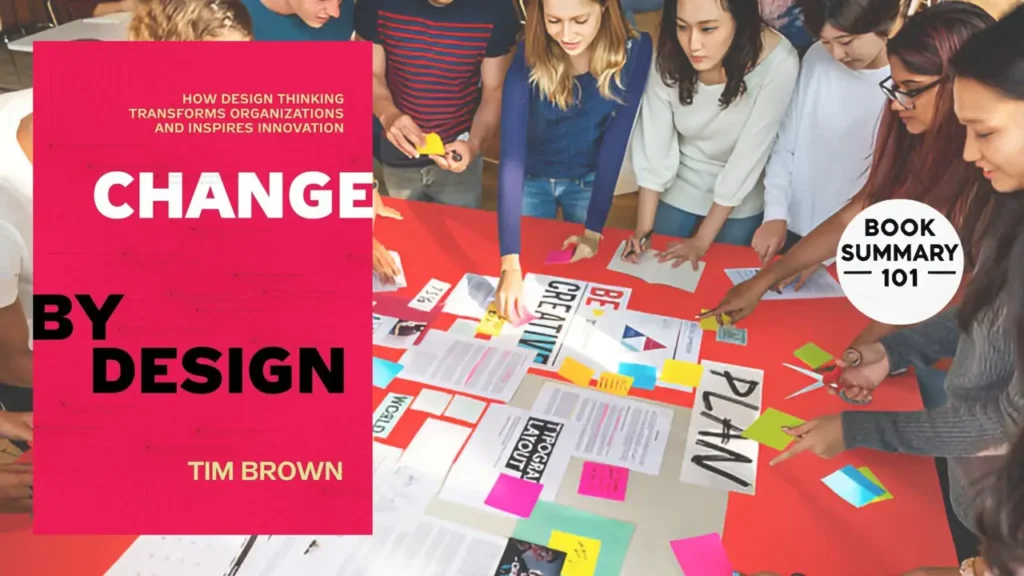In today’s world, we’re all on the hunt for that next big idea, that innovative solution to make our business, projects, or even personal goals stand out. But where does that spark come from? According to Tim Brown in Change by Design: How Design Thinking Transforms Organizations and Inspires Innovation, the answer might just be “design thinking”—a unique, human-centered approach to problem-solving.
Tim Brown is the CEO of IDEO, one of the world’s top design firms, and in this book, he shares not only what design thinking is but why it’s become a driving force for innovation across every industry. The book is packed with insights, tools, and stories that make this mindset approachable for anyone—whether you’re a seasoned leader or someone with a personal passion for creativity.
Let’s dive into what Change by Design offers, and why it’s worth a spot on your reading list!
What Exactly is “Design Thinking”?
At its core, design thinking is about understanding the people you’re designing for, collaborating in new ways, and reframing problems creatively. Brown describes it as a blend of empathy, experimentation, and intuition. Instead of focusing on technical solutions, design thinking starts with people—what they need, how they feel, and what will ultimately serve them best.
A key takeaway is that design thinking isn’t exclusive to designers; it’s for anyone who’s tackling a problem or dreaming up something new. From business strategies to public policy, Brown argues that anyone can tap into this mindset to transform ideas into meaningful action.
The book on amazon 👉 Change by Design 📚
How Design Thinking Drives Innovation
Brown doesn’t just explain design thinking as a concept; he brings it to life with compelling real-world examples of how companies and organizations have used this approach to create meaningful changes. Let’s dive deeper into some of these examples to see exactly how design thinking can bring fresh perspectives to everyday problems.
The Humble Toothbrush Gets a Makeover
When we think about brushing our teeth, it feels pretty routine. But for IDEO, the process of redesigning a toothbrush became an incredible case study in human-centered design. The project started when IDEO partnered with a toothbrush company that wanted to improve its product, specifically for children. Instead of diving straight into a list of technical improvements, the team took a step back and asked: What is brushing like from a kid’s point of view?
IDEO’s team spent time observing children brushing their teeth. They discovered that small hands had difficulty gripping and maneuvering a traditional toothbrush. Through prototyping and testing, they developed a thicker, chunkier handle that was easier for little hands to hold. The team also experimented with bright colors and fun shapes, making brushing feel less like a chore and more like a fun activity.
The impact was significant: the newly designed toothbrush didn’t just solve a functional problem; it created a better experience for kids, making them more likely to brush on their own without a reminder from parents. This approach of focusing on the user experience, not just the end product, set the stage for many future projects at IDEO and is a perfect example of how design thinking can transform an ordinary product into something that truly connects with people.
Banking for Real People: Reimagining Financial Services in Latin America
IDEO took on a unique challenge when a Latin American bank asked them to help design a way to attract customers who traditionally didn’t use banks, including those in underserved and low-income communities. This wasn’t just about designing a product; it was about understanding the lives and concerns of people who had largely avoided traditional banking.
IDEO’s team immersed themselves in these communities, visiting neighborhoods and talking to people who were hesitant about banks. They discovered that the mistrust stemmed not only from the fees or the complexity of services but from a perceived disconnect—customers felt banks didn’t understand or value their specific needs. IDEO used this insight to redesign everything from how branches looked to how staff communicated with customers. For example, they created simpler account options with transparent fee structures, and staff were trained to be more approachable and helpful, removing some of the intimidation and mystery that often surround banking.
The results went beyond attracting new customers; the bank saw a shift in how these communities interacted with financial institutions. By showing a deep understanding of their customers’ lives and values, the bank wasn’t just seen as a business but as a part of the community. This project shows the transformative power of design thinking to solve not only technical problems but to break down social and cultural barriers as well.
Humanizing Health Care: Improving Efficiency and Team Morale
Health care can often be an overwhelming experience for both patients and staff. Hospitals are busy, high-stress environments where every minute matters. Kaiser Permanente, one of the largest health care providers in the U.S., asked IDEO to help them improve the way nurses and doctors interacted during shift changes, which were often chaotic and led to lost information or confusion.
IDEO’s team approached the challenge by immersing themselves in the hospital setting, shadowing nurses, doctors, and administrators to see exactly where things were going wrong. They observed that a lot of vital patient information was being lost in the handoff between shifts. The issue wasn’t just logistical; it created unnecessary stress for staff and reduced the quality of patient care.
Through brainstorming and testing different ideas, IDEO came up with a new approach: a “shift huddle” where nurses and doctors could review patient cases together, using a visible, centralized board to ensure everyone was on the same page. They also created standardized checklists and encouraged face-to-face handovers, rather than written notes alone. These simple changes made a huge difference—not only did they reduce errors, but they also improved morale by giving staff a chance to feel part of a team and directly engaged in patient outcomes.
This project highlighted that, in a system as complex as health care, sometimes the smallest, human-centered changes can make the biggest difference. IDEO’s approach wasn’t just about efficiency; it was about creating a more collaborative, respectful workplace where patients and staff alike could feel valued and supported.
The Shopping Cart Reinvented: Rethinking the Way We Shop
Another famous project from IDEO tackled something most of us use without a second thought: the shopping cart. This project started as a segment for the television program Nightline, where IDEO’s team was asked to redesign the traditional shopping cart in five days.
IDEO set to work by observing how people actually use shopping carts in real grocery stores. They saw that carts often created bottlenecks in aisles and that people struggled with keeping items organized as they shopped. They also noticed that theft and damage were recurring issues with traditional cart designs. From these observations, the team generated a list of needs that weren’t being met and began brainstorming solutions.
The result? A cart with modular baskets that could be removed and taken directly to the checkout or into the trunk of a car. They added a more ergonomic design and improved maneuverability to make the carts easier to push through crowded aisles. While this exact design didn’t end up in stores, it showcased how a deep understanding of users and a willingness to rethink even the most familiar objects can lead to innovative solutions.
Why Do These Examples Matter?
These stories from Change by Design aren’t just case studies; they’re a testament to the power of design thinking in action. Whether it’s reimagining a toothbrush, creating banking systems that build trust, or helping hospital staff deliver better patient care, these examples show that when we place human experience at the center of our design process, we can unlock new, impactful solutions.
Each example underscores that the magic of design thinking lies in looking beyond obvious problems and getting to the root of human experience. In a world full of complex challenges, it’s a refreshing reminder that sometimes, the answer lies in observing, empathizing, and creating solutions that feel authentic and intuitive to the people we serve.
Why Read This Book?
If you’re interested in innovation, creativity, or problem-solving, Change by Design is a must-read. Here’s why:
- It’s Practical and Actionable: Brown doesn’t just talk about big ideas; he gives actionable advice on how to apply design thinking to your own projects, whether you’re in business, education, or a nonprofit.
- It’s Inspiring: Brown’s approach makes you believe that even the toughest challenges can be tackled with creativity and empathy. His stories will have you itching to try out design thinking in your own work.
- It’s for Everyone: You don’t have to be a designer to benefit from this book. Brown makes it clear that this is a mindset, not a job title. It’s about bringing new ways of thinking to whatever you’re passionate about.
Join the Conversation!
Tim Brown’s Change by Design goes beyond traditional methods of problem-solving. It asks us to question assumptions, think like the people we’re designing for, and collaborate in new, meaningful ways.
Have you tried using design thinking in your own projects? Or is this a completely new concept to you? Share your thoughts, and let’s talk about how this approach might inspire some new ideas in your life!
So, what do you think? Ready to see the world through the lens of design thinking?
The book on amazon 👉 Change by Design 📚
5 powerful quotes from Change by Design by Tim Brown:
- “Design thinking is a human-centered approach to innovation that draws from the designer’s toolkit to integrate the needs of people, the possibilities of technology, and the requirements for business success.”
—This captures the essence of design thinking: it’s not just about aesthetics but about solving real-world problems in a way that balances creativity, feasibility, and viability. - “Fail early to succeed sooner.”
—Brown emphasizes the importance of rapid prototyping and learning from mistakes. The sooner you test ideas and iterate, the faster you get to a truly innovative solution. - “A designer’s job is to imagine the world not as it is, but as it should be.”
—This highlights the visionary role of design thinking in shaping better products, services, and experiences for people. - “Empathy is at the heart of design. Without understanding what others see, feel, and experience, design is a pointless task.”
—One of the biggest takeaways from the book is that the best innovations come from deeply understanding people’s needs and challenges. - “Innovation happens when we take chances, experiment, and embrace uncertainty.”
—Brown encourages a mindset shift from avoiding risk to seeing uncertainty as an opportunity for creativity and new discoveries.


